DIGS O' THE DAY (2007-12-15): THE LONDON STREET COINSHOOTING ADVENTURE
 lordmarcovan
Posts: 44,031 ✭✭✭✭✭
lordmarcovan
Posts: 44,031 ✭✭✭✭✭
DIGS O' THE DAY (2007-12-15): THE LONDON STREET COINSHOOTING ADVENTURE
As day broke on Saturday, December 15, 2007, it was apparent that our unseasonably warm trend was continuing. While much of the rest of the country, particularly the Midwest, suffered ice storms and heavy snowfalls or freezing rain, we in Georgia’s Golden Isles were strolling about, often in short sleeves, marveling at weather that was almost freakishly mild and pleasant, even by our semitropical standards. Saturday dawned clear and fine, with a few fat cumulus clouds drifting in a blue sky. I heard a rumor of rain and hoped it stayed away, as I’d been looking forward to today’s scheduled detecting trip all week, and had not been outdoors to enjoy the fine weather we’ve had lately.
As I stepped outside the front door to walk to my van, I was greeted with a worrisome development.
It had begun to rain! The sky had turned whitish-grey and a light drizzle was beginning. It intensified slightly as I loaded my gear.
As long as it doesn’t get any worse than this, I thought, we’ll be okay. It will take more rain than this to stop me! As I drove around the circle at Hanover Park, in Brunswick’s Old Town district, and rolled up to my friend Ty Herig’s door, the light rain slackened a bit. Ty was waiting on the front porch. Seconds later, Steve Smith rolled up, in a sporty black Mustang.
We discussed what to do about the weather, and Steve and I both agreed that the diminishing drizzle wasn’t “real” rain. Steve said, “It’s not REAL rain to me unless the hole I’m diggin’ fills up with water faster than I can scoop it out!”.
Ty, our host on this expedition, had gained us permission to hunt at an old Victorian house on London Street, barely a half block from his home. This house, a beautiful, grand old structure situated at the southeastern corner of London and Richmond Streets, occupies an oversized lot that runs the width of the block. It is one of those places that has that “aura” I can’t fully describe. Let’s just say that the sight of such a place makes a detectorist’s heart beat faster, because you can practically smell all that sweet silver sleeping in the soil. I’d cast a covetous eye on this place twelve years before, in 1995, when I was actively detecting the sidewalk strips and parks of Old Town. And now, thanks to the diplomatic skills of our friend Ty, we were in!
As we strolled down the block towards our destination, a black cat crossed my path. It wasn’t a bad omen, though. It was just Mikey, Ty’s cat, who follows him everywhere, like a dog would. I’ve never found black cats to be bad luck- in fact, some of my best friends have been black cats.
Steve had brought along a spare detector for Ty to use, since Ty, a novice detectorist, had returned the borrowed machine he’d used to find his first Wheat cents and relics with. We work out nicely as a treasure hunting trio, with Steve being a master of the craft, the provider of an extra machine and spare batteries, and a mentor to Ty, just as he had been to me in the early 1980s. Ty is our ambassador, who’s gained us permission at a couple of great sites so far, and I’m the archivist and reporter, as you can see.
Upon arriving at our destination, we briefly discussed the history of the place. According to local lore, the lot had once been part of a site where Confederate soldiers had camped early in the Civil War, long before the house was built in the late 1800s. I’d have dismissed this as rumor, but for the fact that I had dug a lovely South Carolina State Seal button of Civil War vintage in a neighboring lot, back in the 1990s. So the Civil War relic possibilities were not so farfetched, after all. Still, I was here for coinshooting, and more expected to see coins and relics of the late 1800s and early 1900s.
The once-grand house, now vacant and owned by people who live out of town, is sadly beginning to show signs of neglect. It must be horribly expensive to maintain these large old homes.

The hedges and landscaping were growing a bit wild. A boarded up old servants’ quarters stood in part of the backyard.
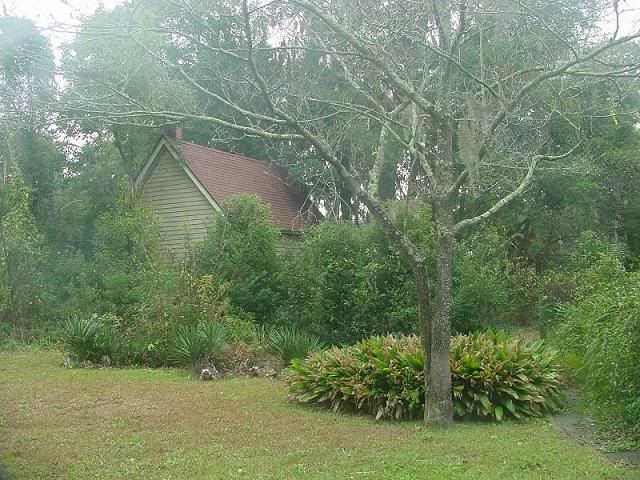
The light rain stopped, and we set to work. I began running a sweep along the sidewalk and down the edge of the property. My first target proved to be a crumbling, whitish piece of corroded zinc, then a small ring, but a brass ring that was obviously not jewelry. It is more like a curtain ring but too small to have been used for that purpose. Kneeling in the grass, I discovered that the sandspurs were pretty awful in this semi-neglected lawn. Those of you who are not from Florida, Georgia, or other semitropical southern places and are unfamiliar with sandspurs should count yourselves lucky not to have them. They're a kind of "sticker" plant that grows like a grass, and the ends of the stalks contain a number of little spiky balls. Unlike other kinds of "hitchikers" whose seeds latch on for a ride, sandspurs have hard, extremely sharp little spines on them that can stick to flesh as well as clothing, sometimes even drawing specks of blood. They're more like tiny cacti in that regard, and soon my jeans and socks were loaded with them. Ouch.
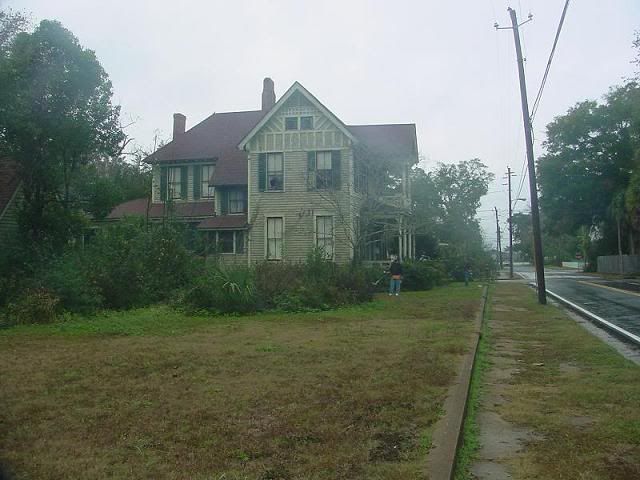
Steve went towards the middle of the yard, adjacent to the old servant’s quarters. Soon he reported the first Wheat cent, and an early one, at that- as early as they come. He’d found a 1909 Lincoln cent! The lack of an “S” mintmark meant it wasn’t a rare San Francisco issue, though. Not long after that, in the same area, he found a 1905 Liberty nickel, and a dateless Buffalo nickel that had been hammered into a convex shape, perhaps for jewelry or a decorated belt. He capped off his success by digging a Wheat cent that was not only an early date, but a semi-key to the Lincoln cent series, as well: a scarce 1910-S!
“Slow down and pace yourself, there, Champ,” I told him, jokingly suggesting that maybe he should take a break so that Ty and I had a fighting chance at all the buried bonanza. Soon I had my first Wheat cent, too, but it was a late-date one; a 1954-D. Ty stood nearby as I dug it, saying he wanted to “watch the master at work”. A nice compliment, to be sure, but I told him if he wanted to watch the TRUE master at work, he was on the wrong side of the yard, and he’d best go see what Steve was up to!
The ratio of coins to trash was good here. It was obvious that this site was going to be every bit as good as I’d hoped. The soil was sandy and loose, which is good because this kind of local soil is often very gentle in terms of the preservation of buried coins, but its looseness makes tidy digging difficult, since one’s plugs tend to crumble and fall apart.
Alongside the sidewalk, I dug a deep signal and brought up a round disc, which, when scrubbed a bit, shone with a dull silvery color. My heart skipped a beat. Alas, this turned out to be just an odd, perfectly coin-shaped disc of lead, with no markings.
Ty found an old key- not a “skeleton” key but an older brass house key, which was not really good enough to be a “keeper”, but better than trash. I explained to him that there’s a difference between “junk” and “trash”. He summed it up thusly: “So… ‘trash’ is the stuff you throw away immediately, whereas ‘junk’ is the stuff you throw away six months later?”
I had to laugh. Obviously, he’s never seen my massive, forty-pound “Dug Junque” drawer. I guess there’s a difference between “junk” and “junque”, too. I’ve had “whatzits” in that drawer that later turned out to be rare finds, so I am reluctant to throw anything out until I’m sure it’s junk… or trash, as the case may be.
Steve and I simultaneously hunkered down to dig very similar dime signals, only a few feet apart. He grumbled about his “poor pinpointing” as he perfectly pinpointed the first silver coin of the day: a bluish-toned 1939 Mercury dime. I told him to quit his bellyaching, as my dime proved to be nothing but a grubby, modern clad coin, and not silver at all.
After Steve and I swung off in different directions, I got a really nice, clear coin signal that registered as a dime at about five inches. I had to carefully avoid the spiky leaves of a Spanish bayonet plant. The sod was firmer here, and I cut a plug and turned it back. There, framed by the bottom of the plug, was the sight I had hoped to see.
The glorious shine of silver twinkled in the weak morning sunlight, brightening the overcast, grey day!
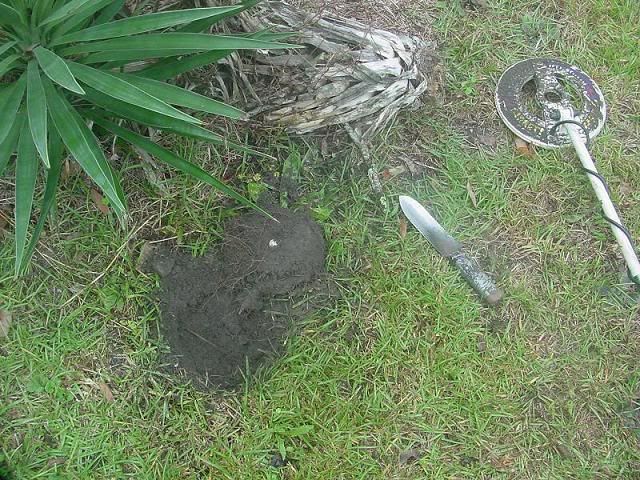
I called Steve over to show him the silver peeking from my plug, telling him he was temporarily forgiven for the beating he was dishing out to us. I’m a bit more forgiving of being thoroughly trounced when I can at least show a little something on the scoreboard for myself. He asked what the date was, but I hadn’t taken the coin out of the dirt yet. It proved to be a 1926-D, a slightly less-common Mercury dime date which I had never dug before. So if nothing else, this alone made my day a success!
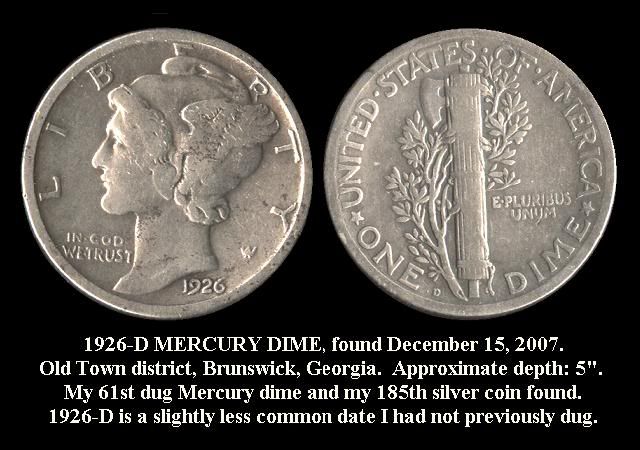
Feeling brash and overconfident now, I challenged The Master to a showdown: we’d have a race to see who dug the first Indian cent of the day. The race was on!
The Master showed his mastery by bagging the first silver quarter of the day: a pretty nice looking 1957-D Washington.
Within a minute or two, my detector sounded off on a target that looked promising for an Indian cent. It registered just below “cent” range on the meter (as Indian cents often do), and was a clear, sharp repeating signal with a depth reading of about six inches. I dug, pinpointing the target, and pulling a brown cent from the soil. Peering through the dirt on its surfaces, I saw a lady in an Indian headdress, and all of the feathers on her headband were crisp and sharp, with every vein and detail distinct!
AHA! THE FIRST INDIAN CENT APPEARS! And a really nice looking one, too! It was a 1907, and the 1907 is the most common date of Indian cent there is, but this coin's exceptional state of preservation more than compensated for that. Obviously this coin had been new when it was lost, perhaps exactly one hundred years ago.
HAHAHAHA! I laughed with maniacal glee, like a old movie villain. I’d beaten The Master at his own game, and won the “Indian Cent Challenge”!
It was a small victory, but it felt great.
"Hey, Steve! What'd I just say, hmm? What were we just discussing? HAHAHAHAHA!"
Steve congratulated me on my victory, and mentioned that we were now in a race to see who would be the first to find a coin from the 1800s. With his 1909 Lincoln cent and 1905 Liberty nickel, and my 1907 Indian cent, we were getting close!
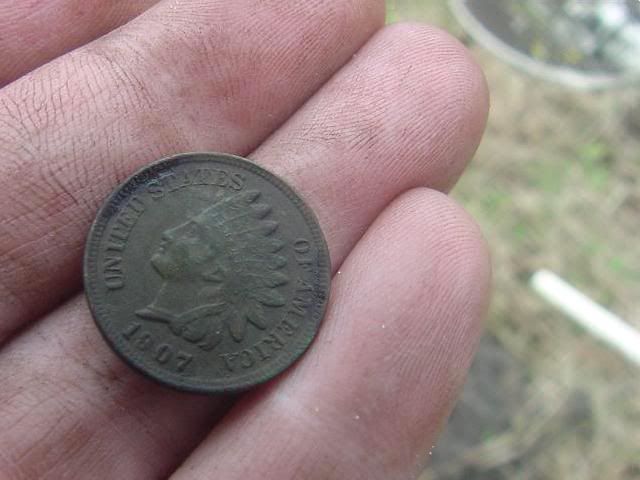
Just then, Ty interrupted our friendly competitive banter, to announce that he had crossed that magical milestone in every new detectorist’s career…
He had dug his first silver coin!
It was a quarter, too: a 1936 Washington. There was much handshaking and congratulations all around, and I told him he’d also crossed a small milestone that I never had: as of this writing, though I have found my share of silver quarters, I have yet to dig a silver Washington from the 1930s.
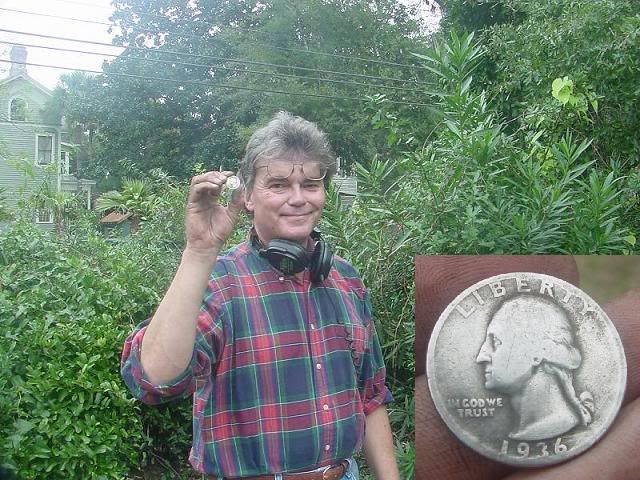
After celebrating Ty’s success, we got back to work and Steve soon announced he’d just beaten me in the “1800s Challenge”.
Awww, dangit.
He’d dug an 1898 Barber dime, from a depth of eight to ten inches! I was simultaneously excited, elated, and envious. A Barber or Seated Liberty dime had been at the top of my realistic desires on this outing. Steve proved how realistic a hope it had been. Awww, man, that was supposed to be MINE!!
Just to rub it in, he followed up with a pretty decent 1923 Buffalo nickel that had a clear date and plenty of detail.
A short while later, Steve called out and asked me if I wanted to race him to the first Standing Liberty quarter.
“Why, did you just dig one?” I asked, arching one eyebrow suspiciously.
He grinned, producing a well-worn Standing Liberty quarter. It was slick and dateless, as worn Standing Liberties often are, but we could see it was a Type 2, minted between 1917 and 1930. Like the first Mercury dime he'd found, this quarter had an unusual but not thoroughly unattractive bluish-grey toning to it. We speculated that this might have been caused by proximity to rotting vegetation in the soil. Since Standing Liberty quarters were only produced for fourteen years, they’re a bit more elusive as detecting quarry- I personally had not dug one in about twelve years.
OK, so The Master was leaving Ty and I way behind, but everybody had succeeded today, directly in proportion to his own level of experience. So it goes in detecting, as with most endeavors, I suppose. While one’s equipment and luck are definite factors, experience is the factor that has the biggest bearing on one’s success.
I got a “quarterish” signal and a relatively deep one, at that. Obviously deep, yet still a clear belltone on the machine, this sort of signal is the kind that gets a detectorist salivating.
Pinpointing the target in the layer of tan-colored sand that lay beneath the grey topsoil, I became excited. Steve’s 1898 Barber dime had been in this lower layer of soil, so if I had a quarter from such a depth… well… the possibilities made me breathless.
Sure enough, the target came up in my hand, and I could see it was round and roughly the size of a quarter! But instead of the reeded edge of a silver coin, I could see it was brown.
WOW… could I be holding my first dug two cent piece, or half cent?!?
Nope. It was an old brass grommet, such as one sees on tents, tarps, or flags. Aaargh!
Next to the grommet I found an old clasp hook that had probably once been attatched to it.
Oh, well.
Another relic I found around this time was brass and heavily ornamented like a spoon handle. But it wasn’t a spoon. It's made of stamped brass, and though the scalloping and decoration are very similar to silverware of the period, it's too thin to have been a piece of tableware. It is plainly Victorian and very fancy, with some script writing on it that says “Wuyler’s”. What it is, I haven’t a clue. Usually I am pretty good at the “guess that mystery relic” game. Sadly, this item is bent up into a twisted ball, so I fear I will be unable to straighten it out without breaking it.
I got another good coin signal and it proved to be a cent with that olive green patina I love to see on a dug coin: the sure sign of old copper or bronze! Often, dug Indian cents will have this color and appearance. Had I just scored another?
Not this time. It was a 1923 Wheatie, which turned out to be the only earlier-date Wheat cent I dug that day.
The next signal produced a small two-piece cuff button. I was hoping for a Confederate button, but this was more probably from the early 20th century. It says “HERCULES” across the front, which is almost certainly a reference to the Hercules pulpwood plant here in town, whose belching smokestacks give Brunswick its affectionate nickname, “The City of a Thousand Smells”. Apparently the Hercules crew once wore uniforms or coveralls with the company name on the buttons.
Steve soon tired out and Ty had stopped detecting, but I kept on, desperate to catch up to The Master. We discussed how it could be that Steve and I use the same model of detector and yet he so consistently outperforms me by a factor of two or three (or more). Part of the reason is that his sweep is slower and more methodical than mine, perhaps. I know how to slow it down and proceed with meticulous concentration, but sometimes this is difficult when one gets excited. Another factor to consider is that Steve actually digs a lot more. I am choosier with the signals I dig. The bad part of this is that I no doubt am leaving goodies behind, but the advantage to it is that I dig much less trash and don’t wear myself out as quickly. Steve ended the day with three or four times as many coins as I did, but possibly three or four times as much trash, too. Both of us marveled at how relatively clean this lot was, and how excellent the ratio of older coins to new ones turned out to be.
Steve’s take, in the end, amounted to an impressive haul, proving the yard had indeed been pristine, untouched detecting territory. Excluding trash and modern coins, he scooped up four Wheat cents dated 1909, 1910-S, 1944, and 1954. In nickels, there was the 1905 Liberty, and two Buffaloes (dateless and 1923). In dimes, he got the 1898 Barber, two Mercuries including a shiny 1936 and the bluish 1939, plus two silver quarters: the dateless Standing Liberty and the 1957-D Washington. In addition, he found two old tokens, one of which bears the number "2530" on one side. I have seen other detectorists find these, which I presume to be from around the 1930s, but I am uncertain what the numbers on them mean. Even for a seasoned detectorist in these parts, Steve's haul of five pieces of silver on a single outing is enviable, and in fact, as of this writing, my personal best in one day was just that- five pieces. He's done even better, on occasion. Those sorts of outings are unforgettable, even for most veteran diggers.

Ty’s haul was modest, amounting to little more than an old key, a 1948 dog rabies vaccination tag, and the 1936 silver Washington, but for a new detectorist wielding a borrowed and unfamiliar machine, it was a fine performance, and shows he’s got the right stuff.
My score, excluding a small amount of trash and some odd junk, was the really sharp 1907 Indian cent, five Wheat cents dated 1923, 1941, 1942, 1954-D, and 1955, plus two modern cents, the 1926-D Mercury dime, and a clad modern dime. So Ty and I each only scored one piece of silver to Steve’s five, but I had the small satisfaction of outscoring Steve in Wheat cent quantity (if not quality), and I was the only one to dig an Indian cent. There must be dozens of those in that yard, but they’ll require further hunting. My additional noncoin finds were the strange “Wuylers’s” Victorian artifact and the odd little lead disc, plus two small brass rings whose function I can only guess at, since they aren’t jewelry rings. It is very rare for me to dig more Wheat cents and old coins than modern cents and clad coins, but I did exactly that this day, much as I had in the last old virgin yard Ty invited me to.
Though tired, I’d have kept on for another hour or so, but Steve and Ty had to go, and it wasn’t a good idea for me to continue detecting in a stranger’s yard without our ambassador’s presence. So we said our goodbyes and I headed home.
Just before I crossed the Lanier Bridge on my way home, I noticed the fog was rolling in, partially swallowing the giant structure. We’ve had a lot of pea-soup fog here lately. It must have something to do with the unseasonably warm air meeting the colder water.
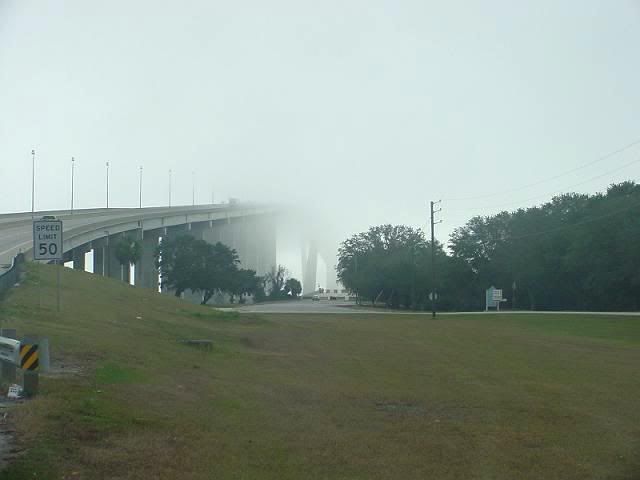
At home that night, I carefully cleaned the 1907 Indian cent, giving it a gentle brushing with a fine-bristle brass wire brush, followed by a rub in a powdered sulfur and Vaseline paste. Though it is the third 1907 I’ve found, it is in amazing condition for a ground find, and is one of the nicest Indian Head cents I have ever dug, if not THE nicest, in terms of condition and preservation. Its glossy brown surfaces are truly incredible for a detector find, and it's obvious it was an Uncirculated coin when it was lost a century ago. Perhaps a future visit to that yard will produce equally well-preserved ones dated in the 1800s. That would be something!
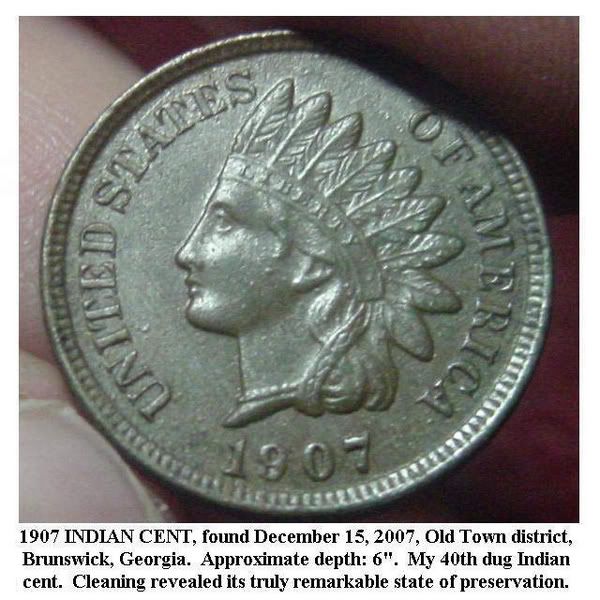
Steve and I had both hoped aloud that the rain would return in the evening, after we'd left, to wash down the grass. Though we'd been as careful as possible with the sod, the loose sandy soil left grey smears on the grass, where we'd replaced the crumbling plugs. A good rain would heal the wounds, rinse off the dried loose soil, and remove all traces of our presence.
That evening, as I retrieved the photos from my camera disc and began mentally composing this tale, I heard the gentle spatter of rain on the roof. Ah, excellent.
All's well- a fitting end to a fine day.
It was an adventure to remember. Perhaps we'll visit this spot again.
I'll talk to you again, dear reader, when next I sit in front of the keyboard as your Diligent Digging Diarist.
2010 update- this site is now closed to detectorists, so don't bother the property owner if you live near here.
~RWS
INDEX OF DIG STORIES
As day broke on Saturday, December 15, 2007, it was apparent that our unseasonably warm trend was continuing. While much of the rest of the country, particularly the Midwest, suffered ice storms and heavy snowfalls or freezing rain, we in Georgia’s Golden Isles were strolling about, often in short sleeves, marveling at weather that was almost freakishly mild and pleasant, even by our semitropical standards. Saturday dawned clear and fine, with a few fat cumulus clouds drifting in a blue sky. I heard a rumor of rain and hoped it stayed away, as I’d been looking forward to today’s scheduled detecting trip all week, and had not been outdoors to enjoy the fine weather we’ve had lately.
As I stepped outside the front door to walk to my van, I was greeted with a worrisome development.
It had begun to rain! The sky had turned whitish-grey and a light drizzle was beginning. It intensified slightly as I loaded my gear.
As long as it doesn’t get any worse than this, I thought, we’ll be okay. It will take more rain than this to stop me! As I drove around the circle at Hanover Park, in Brunswick’s Old Town district, and rolled up to my friend Ty Herig’s door, the light rain slackened a bit. Ty was waiting on the front porch. Seconds later, Steve Smith rolled up, in a sporty black Mustang.
We discussed what to do about the weather, and Steve and I both agreed that the diminishing drizzle wasn’t “real” rain. Steve said, “It’s not REAL rain to me unless the hole I’m diggin’ fills up with water faster than I can scoop it out!”.
Ty, our host on this expedition, had gained us permission to hunt at an old Victorian house on London Street, barely a half block from his home. This house, a beautiful, grand old structure situated at the southeastern corner of London and Richmond Streets, occupies an oversized lot that runs the width of the block. It is one of those places that has that “aura” I can’t fully describe. Let’s just say that the sight of such a place makes a detectorist’s heart beat faster, because you can practically smell all that sweet silver sleeping in the soil. I’d cast a covetous eye on this place twelve years before, in 1995, when I was actively detecting the sidewalk strips and parks of Old Town. And now, thanks to the diplomatic skills of our friend Ty, we were in!
As we strolled down the block towards our destination, a black cat crossed my path. It wasn’t a bad omen, though. It was just Mikey, Ty’s cat, who follows him everywhere, like a dog would. I’ve never found black cats to be bad luck- in fact, some of my best friends have been black cats.
Steve had brought along a spare detector for Ty to use, since Ty, a novice detectorist, had returned the borrowed machine he’d used to find his first Wheat cents and relics with. We work out nicely as a treasure hunting trio, with Steve being a master of the craft, the provider of an extra machine and spare batteries, and a mentor to Ty, just as he had been to me in the early 1980s. Ty is our ambassador, who’s gained us permission at a couple of great sites so far, and I’m the archivist and reporter, as you can see.
Upon arriving at our destination, we briefly discussed the history of the place. According to local lore, the lot had once been part of a site where Confederate soldiers had camped early in the Civil War, long before the house was built in the late 1800s. I’d have dismissed this as rumor, but for the fact that I had dug a lovely South Carolina State Seal button of Civil War vintage in a neighboring lot, back in the 1990s. So the Civil War relic possibilities were not so farfetched, after all. Still, I was here for coinshooting, and more expected to see coins and relics of the late 1800s and early 1900s.
The once-grand house, now vacant and owned by people who live out of town, is sadly beginning to show signs of neglect. It must be horribly expensive to maintain these large old homes.

The hedges and landscaping were growing a bit wild. A boarded up old servants’ quarters stood in part of the backyard.

The light rain stopped, and we set to work. I began running a sweep along the sidewalk and down the edge of the property. My first target proved to be a crumbling, whitish piece of corroded zinc, then a small ring, but a brass ring that was obviously not jewelry. It is more like a curtain ring but too small to have been used for that purpose. Kneeling in the grass, I discovered that the sandspurs were pretty awful in this semi-neglected lawn. Those of you who are not from Florida, Georgia, or other semitropical southern places and are unfamiliar with sandspurs should count yourselves lucky not to have them. They're a kind of "sticker" plant that grows like a grass, and the ends of the stalks contain a number of little spiky balls. Unlike other kinds of "hitchikers" whose seeds latch on for a ride, sandspurs have hard, extremely sharp little spines on them that can stick to flesh as well as clothing, sometimes even drawing specks of blood. They're more like tiny cacti in that regard, and soon my jeans and socks were loaded with them. Ouch.

Steve went towards the middle of the yard, adjacent to the old servant’s quarters. Soon he reported the first Wheat cent, and an early one, at that- as early as they come. He’d found a 1909 Lincoln cent! The lack of an “S” mintmark meant it wasn’t a rare San Francisco issue, though. Not long after that, in the same area, he found a 1905 Liberty nickel, and a dateless Buffalo nickel that had been hammered into a convex shape, perhaps for jewelry or a decorated belt. He capped off his success by digging a Wheat cent that was not only an early date, but a semi-key to the Lincoln cent series, as well: a scarce 1910-S!
“Slow down and pace yourself, there, Champ,” I told him, jokingly suggesting that maybe he should take a break so that Ty and I had a fighting chance at all the buried bonanza. Soon I had my first Wheat cent, too, but it was a late-date one; a 1954-D. Ty stood nearby as I dug it, saying he wanted to “watch the master at work”. A nice compliment, to be sure, but I told him if he wanted to watch the TRUE master at work, he was on the wrong side of the yard, and he’d best go see what Steve was up to!
The ratio of coins to trash was good here. It was obvious that this site was going to be every bit as good as I’d hoped. The soil was sandy and loose, which is good because this kind of local soil is often very gentle in terms of the preservation of buried coins, but its looseness makes tidy digging difficult, since one’s plugs tend to crumble and fall apart.
Alongside the sidewalk, I dug a deep signal and brought up a round disc, which, when scrubbed a bit, shone with a dull silvery color. My heart skipped a beat. Alas, this turned out to be just an odd, perfectly coin-shaped disc of lead, with no markings.
Ty found an old key- not a “skeleton” key but an older brass house key, which was not really good enough to be a “keeper”, but better than trash. I explained to him that there’s a difference between “junk” and “trash”. He summed it up thusly: “So… ‘trash’ is the stuff you throw away immediately, whereas ‘junk’ is the stuff you throw away six months later?”
I had to laugh. Obviously, he’s never seen my massive, forty-pound “Dug Junque” drawer. I guess there’s a difference between “junk” and “junque”, too. I’ve had “whatzits” in that drawer that later turned out to be rare finds, so I am reluctant to throw anything out until I’m sure it’s junk… or trash, as the case may be.
Steve and I simultaneously hunkered down to dig very similar dime signals, only a few feet apart. He grumbled about his “poor pinpointing” as he perfectly pinpointed the first silver coin of the day: a bluish-toned 1939 Mercury dime. I told him to quit his bellyaching, as my dime proved to be nothing but a grubby, modern clad coin, and not silver at all.
After Steve and I swung off in different directions, I got a really nice, clear coin signal that registered as a dime at about five inches. I had to carefully avoid the spiky leaves of a Spanish bayonet plant. The sod was firmer here, and I cut a plug and turned it back. There, framed by the bottom of the plug, was the sight I had hoped to see.
The glorious shine of silver twinkled in the weak morning sunlight, brightening the overcast, grey day!

I called Steve over to show him the silver peeking from my plug, telling him he was temporarily forgiven for the beating he was dishing out to us. I’m a bit more forgiving of being thoroughly trounced when I can at least show a little something on the scoreboard for myself. He asked what the date was, but I hadn’t taken the coin out of the dirt yet. It proved to be a 1926-D, a slightly less-common Mercury dime date which I had never dug before. So if nothing else, this alone made my day a success!

Feeling brash and overconfident now, I challenged The Master to a showdown: we’d have a race to see who dug the first Indian cent of the day. The race was on!
The Master showed his mastery by bagging the first silver quarter of the day: a pretty nice looking 1957-D Washington.
Within a minute or two, my detector sounded off on a target that looked promising for an Indian cent. It registered just below “cent” range on the meter (as Indian cents often do), and was a clear, sharp repeating signal with a depth reading of about six inches. I dug, pinpointing the target, and pulling a brown cent from the soil. Peering through the dirt on its surfaces, I saw a lady in an Indian headdress, and all of the feathers on her headband were crisp and sharp, with every vein and detail distinct!
AHA! THE FIRST INDIAN CENT APPEARS! And a really nice looking one, too! It was a 1907, and the 1907 is the most common date of Indian cent there is, but this coin's exceptional state of preservation more than compensated for that. Obviously this coin had been new when it was lost, perhaps exactly one hundred years ago.
HAHAHAHA! I laughed with maniacal glee, like a old movie villain. I’d beaten The Master at his own game, and won the “Indian Cent Challenge”!
It was a small victory, but it felt great.
"Hey, Steve! What'd I just say, hmm? What were we just discussing? HAHAHAHAHA!"
Steve congratulated me on my victory, and mentioned that we were now in a race to see who would be the first to find a coin from the 1800s. With his 1909 Lincoln cent and 1905 Liberty nickel, and my 1907 Indian cent, we were getting close!

Just then, Ty interrupted our friendly competitive banter, to announce that he had crossed that magical milestone in every new detectorist’s career…
He had dug his first silver coin!
It was a quarter, too: a 1936 Washington. There was much handshaking and congratulations all around, and I told him he’d also crossed a small milestone that I never had: as of this writing, though I have found my share of silver quarters, I have yet to dig a silver Washington from the 1930s.

After celebrating Ty’s success, we got back to work and Steve soon announced he’d just beaten me in the “1800s Challenge”.
Awww, dangit.
He’d dug an 1898 Barber dime, from a depth of eight to ten inches! I was simultaneously excited, elated, and envious. A Barber or Seated Liberty dime had been at the top of my realistic desires on this outing. Steve proved how realistic a hope it had been. Awww, man, that was supposed to be MINE!!
Just to rub it in, he followed up with a pretty decent 1923 Buffalo nickel that had a clear date and plenty of detail.
A short while later, Steve called out and asked me if I wanted to race him to the first Standing Liberty quarter.
“Why, did you just dig one?” I asked, arching one eyebrow suspiciously.
He grinned, producing a well-worn Standing Liberty quarter. It was slick and dateless, as worn Standing Liberties often are, but we could see it was a Type 2, minted between 1917 and 1930. Like the first Mercury dime he'd found, this quarter had an unusual but not thoroughly unattractive bluish-grey toning to it. We speculated that this might have been caused by proximity to rotting vegetation in the soil. Since Standing Liberty quarters were only produced for fourteen years, they’re a bit more elusive as detecting quarry- I personally had not dug one in about twelve years.
OK, so The Master was leaving Ty and I way behind, but everybody had succeeded today, directly in proportion to his own level of experience. So it goes in detecting, as with most endeavors, I suppose. While one’s equipment and luck are definite factors, experience is the factor that has the biggest bearing on one’s success.
I got a “quarterish” signal and a relatively deep one, at that. Obviously deep, yet still a clear belltone on the machine, this sort of signal is the kind that gets a detectorist salivating.
Pinpointing the target in the layer of tan-colored sand that lay beneath the grey topsoil, I became excited. Steve’s 1898 Barber dime had been in this lower layer of soil, so if I had a quarter from such a depth… well… the possibilities made me breathless.
Sure enough, the target came up in my hand, and I could see it was round and roughly the size of a quarter! But instead of the reeded edge of a silver coin, I could see it was brown.
WOW… could I be holding my first dug two cent piece, or half cent?!?
Nope. It was an old brass grommet, such as one sees on tents, tarps, or flags. Aaargh!
Next to the grommet I found an old clasp hook that had probably once been attatched to it.
Oh, well.
Another relic I found around this time was brass and heavily ornamented like a spoon handle. But it wasn’t a spoon. It's made of stamped brass, and though the scalloping and decoration are very similar to silverware of the period, it's too thin to have been a piece of tableware. It is plainly Victorian and very fancy, with some script writing on it that says “Wuyler’s”. What it is, I haven’t a clue. Usually I am pretty good at the “guess that mystery relic” game. Sadly, this item is bent up into a twisted ball, so I fear I will be unable to straighten it out without breaking it.
I got another good coin signal and it proved to be a cent with that olive green patina I love to see on a dug coin: the sure sign of old copper or bronze! Often, dug Indian cents will have this color and appearance. Had I just scored another?
Not this time. It was a 1923 Wheatie, which turned out to be the only earlier-date Wheat cent I dug that day.
The next signal produced a small two-piece cuff button. I was hoping for a Confederate button, but this was more probably from the early 20th century. It says “HERCULES” across the front, which is almost certainly a reference to the Hercules pulpwood plant here in town, whose belching smokestacks give Brunswick its affectionate nickname, “The City of a Thousand Smells”. Apparently the Hercules crew once wore uniforms or coveralls with the company name on the buttons.
Steve soon tired out and Ty had stopped detecting, but I kept on, desperate to catch up to The Master. We discussed how it could be that Steve and I use the same model of detector and yet he so consistently outperforms me by a factor of two or three (or more). Part of the reason is that his sweep is slower and more methodical than mine, perhaps. I know how to slow it down and proceed with meticulous concentration, but sometimes this is difficult when one gets excited. Another factor to consider is that Steve actually digs a lot more. I am choosier with the signals I dig. The bad part of this is that I no doubt am leaving goodies behind, but the advantage to it is that I dig much less trash and don’t wear myself out as quickly. Steve ended the day with three or four times as many coins as I did, but possibly three or four times as much trash, too. Both of us marveled at how relatively clean this lot was, and how excellent the ratio of older coins to new ones turned out to be.
Steve’s take, in the end, amounted to an impressive haul, proving the yard had indeed been pristine, untouched detecting territory. Excluding trash and modern coins, he scooped up four Wheat cents dated 1909, 1910-S, 1944, and 1954. In nickels, there was the 1905 Liberty, and two Buffaloes (dateless and 1923). In dimes, he got the 1898 Barber, two Mercuries including a shiny 1936 and the bluish 1939, plus two silver quarters: the dateless Standing Liberty and the 1957-D Washington. In addition, he found two old tokens, one of which bears the number "2530" on one side. I have seen other detectorists find these, which I presume to be from around the 1930s, but I am uncertain what the numbers on them mean. Even for a seasoned detectorist in these parts, Steve's haul of five pieces of silver on a single outing is enviable, and in fact, as of this writing, my personal best in one day was just that- five pieces. He's done even better, on occasion. Those sorts of outings are unforgettable, even for most veteran diggers.

Ty’s haul was modest, amounting to little more than an old key, a 1948 dog rabies vaccination tag, and the 1936 silver Washington, but for a new detectorist wielding a borrowed and unfamiliar machine, it was a fine performance, and shows he’s got the right stuff.
My score, excluding a small amount of trash and some odd junk, was the really sharp 1907 Indian cent, five Wheat cents dated 1923, 1941, 1942, 1954-D, and 1955, plus two modern cents, the 1926-D Mercury dime, and a clad modern dime. So Ty and I each only scored one piece of silver to Steve’s five, but I had the small satisfaction of outscoring Steve in Wheat cent quantity (if not quality), and I was the only one to dig an Indian cent. There must be dozens of those in that yard, but they’ll require further hunting. My additional noncoin finds were the strange “Wuylers’s” Victorian artifact and the odd little lead disc, plus two small brass rings whose function I can only guess at, since they aren’t jewelry rings. It is very rare for me to dig more Wheat cents and old coins than modern cents and clad coins, but I did exactly that this day, much as I had in the last old virgin yard Ty invited me to.
Though tired, I’d have kept on for another hour or so, but Steve and Ty had to go, and it wasn’t a good idea for me to continue detecting in a stranger’s yard without our ambassador’s presence. So we said our goodbyes and I headed home.
Just before I crossed the Lanier Bridge on my way home, I noticed the fog was rolling in, partially swallowing the giant structure. We’ve had a lot of pea-soup fog here lately. It must have something to do with the unseasonably warm air meeting the colder water.

At home that night, I carefully cleaned the 1907 Indian cent, giving it a gentle brushing with a fine-bristle brass wire brush, followed by a rub in a powdered sulfur and Vaseline paste. Though it is the third 1907 I’ve found, it is in amazing condition for a ground find, and is one of the nicest Indian Head cents I have ever dug, if not THE nicest, in terms of condition and preservation. Its glossy brown surfaces are truly incredible for a detector find, and it's obvious it was an Uncirculated coin when it was lost a century ago. Perhaps a future visit to that yard will produce equally well-preserved ones dated in the 1800s. That would be something!

Steve and I had both hoped aloud that the rain would return in the evening, after we'd left, to wash down the grass. Though we'd been as careful as possible with the sod, the loose sandy soil left grey smears on the grass, where we'd replaced the crumbling plugs. A good rain would heal the wounds, rinse off the dried loose soil, and remove all traces of our presence.
That evening, as I retrieved the photos from my camera disc and began mentally composing this tale, I heard the gentle spatter of rain on the roof. Ah, excellent.
All's well- a fitting end to a fine day.
It was an adventure to remember. Perhaps we'll visit this spot again.
I'll talk to you again, dear reader, when next I sit in front of the keyboard as your Diligent Digging Diarist.
2010 update- this site is now closed to detectorists, so don't bother the property owner if you live near here.
~RWS
INDEX OF DIG STORIES
Collector since 1976. On the CU forums here since 2001.
0
Comments
we have about 14 inches of SNOW here
shoveling, raking the roof every time it snows, icicles-real ones
Wisconsin is so lovely now
we have 4 seasons here, early winter, winter, late winter, and summer
Jim
Menomonee Falls Wisconsin USA
http://www.pcgs.com/SetRegistr...dset.aspx?s=68269&ac=1">Musky 1861 Mint Set
G Man
Rick
1836 Capped Liberty
dime. My oldest US
detecting find so far.
I dig almost every
signal I get for the most
part. Go figure...
To support LordM's European Trip, click here!
But a vivid adventure deserves vivid retelling, and that makes for a lot of words, right?
Collector since 1976. On the CU forums here since 2001.
me and rick have similar hunts. we have days when we kick each others' butt.
Collector since 1976. On the CU forums here since 2001.
Thanks for the ride along.
Jerry
This one can pay for itself.
Besides, it doesn't cost much after the initial outlay for a machine. Just batteries. And time.
Well, gas for one's vehicle IS a consideration, these days, I suppose.
Collector since 1976. On the CU forums here since 2001.
First the 1898 Barber Dime.....
The 1905 "V" Nickel:
The 1909 Lincoln.....pretty bad shape though....no "S" or VDB on this coin....
The 1910-S Lincoln, not bad shape:
A 1923 Buffalo Nickel:
The 1936 Mercury Dime:
The 1939 Merc Dime:
The 1957-D Washington Quarter:
and finally a dateless Standing Liberty Quarter, which to me is the hardest "modern" coin to find:
We really had a great time, and TY and LM are the best hunting partners a person could have.
Looks like I'll have to limit my treasure hunts to the coin return slot of the CoinStar machine until all this snow melts...........maybe March....or April.
I dunno if my episodes run too long for their print format or not.
Collector since 1976. On the CU forums here since 2001.
HH,Tom
<< <i>Another relic I found around this time was brass and heavily ornamented like a spoon handle. But it wasn’t a spoon. It's made of stamped brass, and though the scalloping and decoration are very similar to silverware of the period, it's too thin to have been a piece of tableware. It is plainly Victorian and very fancy, with some script writing on it that says “Wuyler’s”. What it is, I haven’t a clue. Usually I am pretty good at the “guess that mystery relic” game. Sadly, this item is bent up into a twisted ball, so I fear I will be unable to straighten it out without breaking it. >>
Thanks to Riccar's recent discovery of a much less twisted and bent example, I have solved my little mystery: it's a pair of sugar tongs.
Collector since 1976. On the CU forums here since 2001.
You guys get a big old YOU SUCK from me.
Collector since 1976. On the CU forums here since 2001.
Collector since 1976. On the CU forums here since 2001.